 Photographer Arno Rafael Minkkinen came to Austin Peay State University to present a lecture as part of the Visiting Artist Lecture Series sponsored by the APSU Department of Art, and the APSU Center of Excellence for the Creative Arts. “Art is Risk Made Visible” began his presentation. The standing room only lecture featured around 300 slides that he used to highlight his nearly 40 year career. He was introduced by APSU Professor of Photography, Susan Bryant.
Photographer Arno Rafael Minkkinen came to Austin Peay State University to present a lecture as part of the Visiting Artist Lecture Series sponsored by the APSU Department of Art, and the APSU Center of Excellence for the Creative Arts. “Art is Risk Made Visible” began his presentation. The standing room only lecture featured around 300 slides that he used to highlight his nearly 40 year career. He was introduced by APSU Professor of Photography, Susan Bryant.
Minkkinen has a enduring love for the ruggedness of the human body, which he frequently contrasts nude against the unspoiled beauty of the natural world. His photographs make use of natural lighting and shadows with the deft touch of a Renaissance painter. However he also possesses the skill of a master magician who never reveals his tricks; as he eschews any kind of artificial manipulation in his photographs including the use of assistants, “Make them single negatives: This means no manipulation of any kind.”
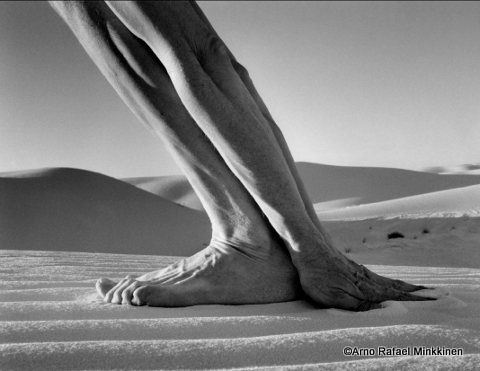
He also loves to travel, his photographs have been taken in such diverse locations including Finland, China, Czechoslovakia, Estonia, Italy, Sweden, Switzerland, Norway, Mexico, and the United States.
Born with a double cleft palate, Minkkinen was subjected to numerous operations early in his life to correct this defect. He later overcame the self confidence issues that this condition normally engenders. “That’s when I did the unthinkable: I began to ask the most beautiful women in college to go out with me. I would date one after another…The conversations were wonderful. I learned to know them as real persons, not objects. Still, the way the wind tugged at their skirts, they way they smiled, the way their perfume mingled with the sea breeze, delighted all my senses,” he said.
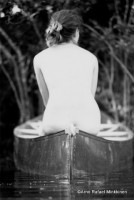
His photography with nude women carries with it that innocent sense of delight.
This is how he met Sandra Jean Hughes, the woman who would become his wife in 1969. “Within one year, I had completely changed. I had learned to accept my physical limitations and draw strength from them. One of the last of these dates, in fact, brought a treasured difference. I sensed that my feelings were reciprocated. I could feel it in the way she held my hand. At a formal garden party, in the cool evening air, she took my breath away.”
His path as a photographer was set after attending a photography workshop at the famous photography center of Apeiron in Millerton, New York.
It began one summer afternoon in the foothills of the Catskills at a place called Apeiron, the hippie-run workshop that fueled photo majors on granola and D-76 in the time of Maggie Mae and “Old Man, take a look at my life, I’m a lot like you were.”
Well, here I am, old hat myself; still jolted by the magic of unmanipulated split-second exposures and sweet transformations in the birth trays of the darkroom.
Returning from Apeiron—where I had hoped to study with Diane Arbus in the summer she left this world—my wife could not recognize me.
“What happened to you?”
In answer, I showed a self-portrait I had made, an image of me standing naked before a mirror like someone at the foot of an open grave.
John Benson, my instructor, had told me to take a day off. “No more cows, no more barns, or back to your [advertising] typewriter you go.”
Seeing the self-portrait, friends later would exclaim: “That’s heavy, dude!” I was hooked.
We all have our own Apeiron to call home, where for the first time we discover how to make the risk visible. My tactic was simple: let the camera take the picture. Not many folks worked that way back in 1971. Finding out what happened after the fact was awesome.
Back at the agency I wrote a headline for Minolta: “What happens inside your mind can happen inside a camera.”
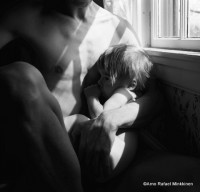
In 1979 his son Daniel Hughes Minkkinen was born, and was soon “invited” into his father’s photography, “In 1979, when our son Daniel was born, I decided to invite him into my photographs. Being without clothes was as natural as the sunshine. Finnish blood ran through our veins.”
Good art will sometime make you feel uncomfortable , force you to change your perspective, and make you grow as a person. That is something I came to face during the lecture with Arno Minkkinen when he showed nude photos of himself with his son. While the photos were innocent and totally non-prurient, they touched up against those puritanical sensibilities so imbued into the fabric of American culture, as we have been taught by our society that photographs featuring nude children are taboo.
“The same nude skin, smooth or wrinkled as the case might be, and all the fun one could want in those blessed years I was able to be home with him,” said Minkkinen. Through the photographs of him and his son, we were privileged to see his child grow to become a fine young man.

Minkkinen offered attendees these tips on how to work the way he works, illustrated by works he created during his career that highlighted these same points:
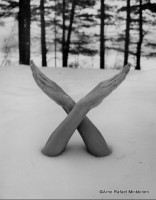
- Make them self-portraits: so no one comes in harm’s way
- Make them self-portraits: because you control how much pain you can tolerate
- Title them self-portraits: so the viewer knows who is in the picture and who took it
- Make them single negatives: This means no manipulation of any kind
- Work the way a documentary photographer works: if you are going to be under the snow be under the snow
- Empower your camera: Entering the scene means trusting the camera to finish the job
- Try not to age: You’re getting there. In four years you could match that record, for what it’s worth.
- Work in the nude: Aim for timelessness by creating an equal sign between nature and nudity
- Embrace mystery: Only the camera knows what happened
- Learn to draw: See what the camera might have seen
- Accept failure: The good ones are rare gifts
- Make sure you have an exit strategy
- Have fun
Some of Arno Minkkinen’s work is included in the Manifold exhibit, which is on display in the Trahern Art Gallery at APSU until October 1st.
About Arno Rafael Minkkinen

Arno Rafael Minkkinen is a Finnish American photographer, educator, curator and writer. Over two hundred one-person and group exhibitions at galleries and museums worldwide includes the recent traveling exhibition titled SAGA: The Journey of Arno Rafael Minkkinen, Thirty-Five Years of Photographs with venues in Massachusetts, Eastern Europe, Finland, Italy and Canada. His self-portrait photographs have been published internationally with six monographs: Frostbite (Morgan & Morgan, 1978); Waterline (Marval, Aperture, and Otava, 1994), Grand Prix du Livre at the 25th Rencontres d’Arles; Body Land (Motta, Nathan, and the Smithsonian Institution Press, 1997-1999); SAGA: (Chronicle Books, 2005), Special Jury Prize at the 2nd Lianzhou International Photography Festival in China; and Homework: The Finnish Photographs, 1973 to 2008 (Like Publishing Ltd., 2008); and Swimming in the Air (Cavallo Point, 2008).
Minkkinen’s works are in prominent museum and institutional collections worldwide: the Museum of Modern Art in New York; the Museum of Fine Arts Boston; the Addison Gallery of American Art in Andover, Massachusetts; the High Museum, Atlanta, Georgia; the National Gallery of Canada, Ottawa; the Center for Creative Photography in Tucson, Arizona; the Musée d’Élysée in Lausanne, Switzerland; the Georges Pompidou Center in Paris; the Musée d’art moderne de la ville de Paris, the Contemporary Art Museum Kiasma in Helsinki; and the Tokyo Metropolitan Museum of Photography in Japan among many others.
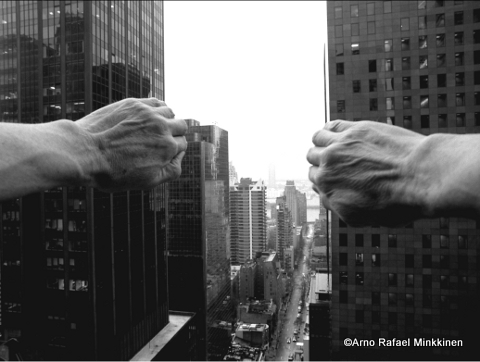
Minkkinen is Professor of Art at the University of Massachusetts Lowell, Docent at the University of Art & Design Helsinki, and graduate faculty at Rockport College in Rockport, Maine. Previous teaching affiliations include École d’Arts Appliqués in Vevey, Switzerland, the Lahti Design Institute in Lahti, Finland, the Philadelphia College of Art (now University of the Arts), and the Massachusetts Institute of Technology.
Galleries around the world which represent Minkkinen’s works include the Robert Klein Gallery in Boston, Barry Friedman Ltd. and Tibor de Nagy Gallery in New York, Fay Gold Gallery in Atlanta, Galerie Anhava in Helsinki, Galerie Agathe Gaillard in Paris, and SEE + Gallery in Beijing. Photo & Contemporary in Torino, Galerie Valerié Bach in Bruxelles, and SEE + Art Space Gallery in Beijing.
Minkkinen’s works can also be seen online at Artnet’s Artist’s Works Catalogue pages.
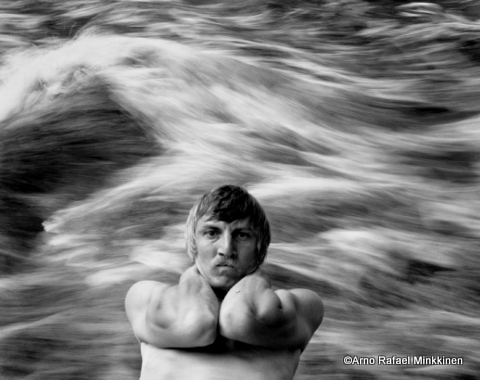
Professor Minkkinen is also an aspiring film director and screenwriter. A feature-length film to be produced in Finland is in the works with Kimmo Koskela, co-director. Koskela directed the award-winning 1995 hour-long documentary, Still Not There , on Minkkinen’s life and work for Finnish television. The film is being released on DVD in 2010 as part of Arno Rafael Minkkinen, Forty Years of Photography.
In 1992, the Finnish government conferred knighthood with the First Class Order of the Lion medal. In 2006, Minkkinen was awarded the Finnish State Art Prize in Photography.
Photo Gallery
The Visiting Artist Lecture Series
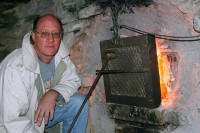
The Visiting Artist Lecture Series continues on October 7th with a lecture by Ceramicist Peter Rose.
- 7:00pm Oct. 7th, Ceramicist Peter Rose, Marjorie Trahern Lecture Hall
- 7:00pm Oct. 28th, Photographer Adi Nes, Marjorie Trahern Lecture Hall
- 7:00pm Nov. 22nd, New Media Artist Yael Kanerek, Trahern Lecture Hall
- 7:00pm Jan. 31st, Gregg M. Horowitz on Aesthetics, Marjorie Trahern Lecture Hall



